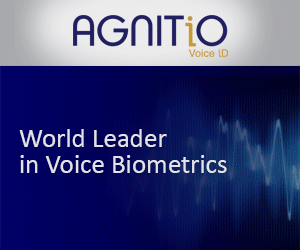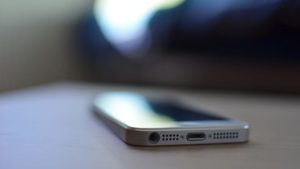The Sound of Your Voice
 Voice recognition is becoming an incredibly popular biometric authentication method thanks to the spread of connectivity and the gradual shift to a post-password paradigm. As we explored in last week’s Voice Month primer, voice recognition can serve a wide range of applications, seeing deployment in criminal ID, on cell phones and at banks. That said, voice is also a unique biometric modality, with very specific strengths, and it is currently in a maturation phase, finding its place in an increasingly multimodal world of authentication.
Voice recognition is becoming an incredibly popular biometric authentication method thanks to the spread of connectivity and the gradual shift to a post-password paradigm. As we explored in last week’s Voice Month primer, voice recognition can serve a wide range of applications, seeing deployment in criminal ID, on cell phones and at banks. That said, voice is also a unique biometric modality, with very specific strengths, and it is currently in a maturation phase, finding its place in an increasingly multimodal world of authentication.
One of the greatest boons of voice biometrics is it’s hands free nature, an aspect that in the past has given it the title of “invisible biometrics”. Though this clearly positions voice recognition as ideal for mobile and wearable tech deployments, allowing for convenient and contactless authentication, the modality reigns supreme in the contact center.
Voice recognition benefits from major traction as a method of identifying customers who phone into call centers, particularly those run by mobile carriers and telecoms. Indeed, even as voice recognition branches out to more consumer-facing markets, Opus Research states in its comprehensive Voice Biometrics Consensus report that call center applications accounted for 41 percent of all instances of voice biometrics in 2014.
It is this sort of strong foothold in an elusive niche that characterized voice biometrics so well. As biometrics become more ubiquitous, this specialization will become more common and possibly essential to the strong authentication methods of the near future. In the same way that voiceprint identification makes over-the-phone operations more secure and orders of magnitude more convenient, it will soon carve out other super-specialized areas of expertise.
The Sound of Panic
 If the impeding popularity of a technology is foreshadowed by anything it is quite often heralded by controversy. This is not uncommon for any given biometric modality, and in many ways it seems like a necessary rite of passage in acheiving full maturity as a consumer-ready product. Just as panic began to spread after the initial launch of Apple’s Touch ID fingerprint sensor, the privacy concerns around facial recognition that surrounded biometric on wearables, and even the extreme reactions of the Florida Senate stemming from biometric time and attendance solutions in schools, voice has found itself the focus of skeptical controversy.
If the impeding popularity of a technology is foreshadowed by anything it is quite often heralded by controversy. This is not uncommon for any given biometric modality, and in many ways it seems like a necessary rite of passage in acheiving full maturity as a consumer-ready product. Just as panic began to spread after the initial launch of Apple’s Touch ID fingerprint sensor, the privacy concerns around facial recognition that surrounded biometric on wearables, and even the extreme reactions of the Florida Senate stemming from biometric time and attendance solutions in schools, voice has found itself the focus of skeptical controversy.
As voiceprint authentication has become more popular, minor controversy has followed it too.
Last November, shortly after financial institution Barclays announced that it will be rolling out finger vein and voice biometrics on a wider scale for client authentication, the media took hold of a fact some found to be of concern in regards to privacy: a survey conducted by the Associated Press revealed that more than 65 million voiceprints have been captured around the world in the past two-to-three years.
Worry began to stir around what this technology might mean for the future of anonymity, particularly in the case of essential staple in law enforcement like anonymous tip hotlines. What was made abundantly clear through the resulting discussion, however, was the benefits that voiceprint biometrics can bring to everyday operations. In the end, voiceprints survived the controversy, the public understands them more, relying parties understand the public’s concerns and the technology is more prominent in the public’s mind.
Judging by how well fingerprint scanners are being accepted (especially by young people) post iPhone S5 controversy, the voiceprint scare in November was an expected hiccup along the road to maturity.
The Sound of Progress
 So, if voice biometrics finds it’s best homes in niches, where does the modality belong outside of the contact center? The proliferation of fingerprint sensors on smartphones and tablets would have one lean away from mobile wallets following in the footsteps of Apple Pay and its competitors, so what needs can voice recognition satiate?
So, if voice biometrics finds it’s best homes in niches, where does the modality belong outside of the contact center? The proliferation of fingerprint sensors on smartphones and tablets would have one lean away from mobile wallets following in the footsteps of Apple Pay and its competitors, so what needs can voice recognition satiate?
On a basic level, voice recognition can serve the consumer demand for strong authentication in situations where a fingerprint sensor is inconvenient. Using Apple Pay as an example once again, let’s consider how the popular mobile wallet integrates with the upcoming Apple Watch. The smartwatch, as with all wearables, is being positioned as a device that brings further convenience to a mobile lifestyle. However, the Apple Pay function on Apple Watch requires a PIN to be entered as opposed to the biometric authentication offered when using the iPhone itself.
One of the biggest barriers in mCommerce adoption, and Apple mentioned this in the Apple Pay announcement, is convenience. Paying with an iPhone needs to be more convenient than paying with a credit card, and that’s no easy feat. A combination of essential partnerships and biometric authentication, as well as an attractive privacy policy managed to be enough for Apple Pay. But on the Apple Watch, the convenience and speed of biometrics is missing when it comes to payment.
Human speech has become the primary method of interface with other wearables like the popular Motto 360, so adding voice recognition to authorize payments seems like a convenient and easy fit. The functionality exist too, with the highly recognized KIVOX Mobile solution from AGNITiO being the most prominent example that comes to mind in voice biometric mCommerce.
Similarly, as the Internet of Things becomes more of a reality to the everyday businessperson and consumer, security is also required. IoT has been singled out a lot recently for the security concern that it poses, and biometric authentication, thanks to it’s handsfree, contactless nature, is positioned perfectly to solve this problem.
Additional growth areas for voice biometrics have been identified in Opus’s census as well. Healthcare, financial services and e-government are all named as verticals ripe for voice authentication adoption, with telecom continuing to be a dominant area in this respect.
The opportunities for growth are particularly friendly to voice biometric adoption over the next few years, with Opus predicting that market revenues will grow to $584 million in 2017. Considering that 2014 brought revenues of about $220 million, this is particularly impressive for such a specialized technology.
The Sound of Diversity
 Perhaps one of the most interesting uses for voice biometrics is one you may have encountered yourself. As the biometrics industry players and their partners attempt to address the challenges of liveness detection and irrevocability, they are turning to multi-factor biometrics and voice recognition is constantly being selected as a wingman.
Perhaps one of the most interesting uses for voice biometrics is one you may have encountered yourself. As the biometrics industry players and their partners attempt to address the challenges of liveness detection and irrevocability, they are turning to multi-factor biometrics and voice recognition is constantly being selected as a wingman.
Two examples come immediately to mind, and many more are sure to follow in this tradition. AppLock, the new logical access control software from Sensory, and the USAA mobile app. Both use a combination of face biometrics and voice recognition to offer convenient, high-security protection on mobile devices.
When factors are combined like this, the authentication process becomes much more difficult to subvert. Those worried about having their face spoofed with a photo or mask, can rest easy knowing that their voice must be used for access as well. Throw in the fact that some voice software, like AGNITiO’s Voice ID, already boasts advanced liveness detection, and users can be assured that they are extra well protected.
Multi-factor authentication is becoming a go-to response to the common criticism of the problem of irrevocability, and just as voice biometrics have found a niche in hands free mobile applications, so have they found one here. Voice recognition, thanks to its versatility, is the modality that is filling in the many cracks and crevices in the evolving connected security ecosystem and ensuring a secure and convenient future.
*
Stay posted to FindBiometrics throughout February as we dig deeper into the world of voice biometrics. Be a part of the conversation by following us on Twitter and using the hashtag #FBVoiceMonth.
Don’t forget to sign up for our upcoming Voice Month webinar: Voice Biometrics in a Multi-Modal Future.
Voice Month at FindBiometrics is made possible thanks to our sponsors: AGNITiO, VoiceVault and SpeechPro USA.
—
February 11, 2015 – by Peter B. Counter


Follow Us